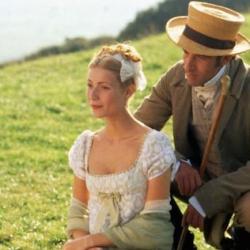Margaret Doody’s Jane Austen’s Names is a treasure chest. On the assumption that “an artist cannot do anything slovenly,” Doody explores the historical significance of the real place names that appear in Austen’s novels, teases out the puns in the characters’ names, suggests that Austen was sensitive to the ethnic resonances of place and personal names. Sometimes Doody’s book is a bit rich with information, but she writes so breezily that you feel that you can take it all in.
She opens with this riff on the temporal allegory in Emma: “Jane’s pianoforte arrives on Saint Valentine’s Day; Frank almost confesses the true state of affairs to Emma on Shrove Tuesday (22 February), a proper time for confessions. The Box Hill expedition takes place on Midsummer Day (New Style). Midsummer madness briefly reigns. Mr. Knightley proposes to Emma on Old Midsummer Day” (4).
Austen’s letters reveal her to be a great lover of wordplay. She is not above making a joke of someone’s name after watching the funeral procession pass her house. The puns could be racy. Mary Crawford is undoubtedly alluding to sodomy in the British Navy when she disclaims that she doesn’t mean to make a pun by speaking of “Rears and Vices” (quoted, 8). In a letter to Cassandra, Doody suggests, Austen plays with the names of a Dr Phillot and his wife Frances (Fanny); she takes Phillot as “Fill-it,” and takes Frances as Fanny, a common slang term for female genitals (9).
Sometimes the punning turns allegorical: “Austen is not as fond of open allegory as Fielding or Richardson and offers us less of overt Eden. To be sure, Uncle ‘Gardiner’ in Pride and Prejudice takes us gently back to Adam, and in Emma even the most delicate of beautiful maidens (to whom the author has given her own first name) retains Eve’s taste for the apple – if only baked apples. Jane Austen, while producing multiple meanings avoids obtrusive allegory – but not all allegory” (10).
Doody offers this shrewd summary of Austen’s “poetics of anachronism, of multiplicity”: “Persons reflect places, and places reflect times and individuals. Times collide with each other, one even or concept seeps into others, adding color and flavoring like wine in water. Austen’s fiction is at one level . . . a perfect mastery of all the techniques of ‘realism.’ But in her earliest surviving works the teenage Austen gave naturalism and realism – and all formulas of rhetoric – good kicks in the backside. She engages in a new kind of surreal comedy. It is foolish to believe that she was committed heart and soul to ‘realism’ – which is merely another set of games with words. Her mature fiction . . . works so well . . . because of its odd density and because its assumed stabilities are counteracted by mercurial instability. . . . Puns, playfulness, history, comedy and tragedy, historical realities of grandeur and loss – these all at work at once. They are not driving us toward a simple once-to-one equivalent but toward a poetic rather than a prosaic encounter with the complex contradictory texture of life” (17-18).
Shrewd, yes. And certainly on target in the main. But edging Austen more than is warranted toward magical realism and other floaty postmodernisms.













